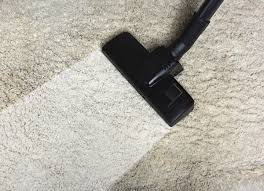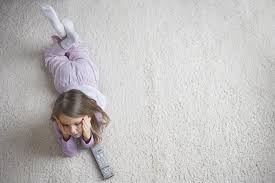Should I Buy New Carpet or Have My Old Carpets Cleaned?
When your carpets are starting to look like they have seen better days, you may be wondering if it is time to get new ones or if you should try to salvage the ones you currently have. It is always cheaper to repair rather than replace, but there will be some instances in which buying new carpets is necessary. A general rule is to replace your carpets when they currently pose health risks like harboring mold or allergens. If your carpets have just a few stains, however, you can likely get professional cleaning help to restore them to their original glory.
Here are some ways to decide if you should replace your carpet or save hundreds and have it cleaned.
Matted Carpet
A sure way to tell if you need new carpet is if the high traffic areas are matted down. If your carpet is made of Polyester or Polyester blends then matting is a sure sign of needing replacement. Once Polyester fibers lose their tuft or shape there is nothing that can be done to revive them. If you have carpet made of a higher quality fiber such as nylon it may be possible to revive it with a professional cleaning. Nylon is one of the most resilient and easiest carpet fibers to revive with a professional cleaning.
Berber Carpet
Carpets made of Olefin fibers have a shorter life span than other berber carpets. Olefin tends to be an oily fiber that attracts dirt and stains after time. When the fibers in Olefin berber carpets begin to matt and lay down it is hard to revive them. The life expectancy of an Olefin berber carpet is around three years, so if your Olefin carpet is looking dingy and matted it may be best to begin looking for a replacement.
Again nylon is a much more resilient fiber and nylon berber carpets will last a lot longer than other berbers. Nylon is more expensive but you get what you pay for. The average life of nylon berber is 10 years. A nylon berber carpet is more than likely able to be restored to like new with a deep professional cleaning.
Permanent Stains
No carpet is safe from the potential of permanent stains; there are however a number of ways to care for carpet to prevent stains from becoming permanent. Many carpets sold today come with some sort of stain resistant coating the most popular being Scotchgard. Scotchgard does wear off over time and can be reapplied by a professional carpet cleaner. If you have a stain master carpet the stain fighting is part of the fiber and there is no need to reapply.
Even with a great stain coating on your carpet it is possible to stain the carpet permanently with certain substances. If you have some ugly stains hanging on to your carpet fibers it is a good idea to call a carpet cleaning professional and ask their advice on weather the stain is removable. Some carpets are beyond hope and better off being replaced.

When do I need to buy new carpets?
If your carpets have incredibly stubborn stains that don’t respond to professional cleanings, then you will likely need to replace them. Also, if they harbor allergens or other health hazards, you should also remove them. Here are some instances in which buying new carpets is almost always necessary:
- Your carpets have recently been damaged by a flood
- There is mold in your carpets
- Your carpets are stained with biohazards like waste
- The stains won’t come out even after a professional cleaning
In addition, you should replace your carpets with high-quality carpets that are stain-resistant. This precaution ensures that future stains won’t force you to spend a lot of money on new carpets.

Why should you replace your old carpet?
Regardless of how durable the material used to make your carpet and padding is, you can expect it to reach its lifespan at one point in time. If you notice any of the following on your old carpet, then, it’s time to invest in a new floor covering:
1. Matting
When matting begins to occur more frequently on the sections of your carpet that experience the most foot traffic, it’s time to replace your old carpet with a new one. Even a professional clean up job can’t do much to reverse the unsightly look of a pile that stays matted down.
2. Staining
An old carpet most likely has collected old stains during the course of its use. Over time, even hiding the stains using area rugs and furniture becomes tiring and- perhaps- detrimental to your interior décor. This leaves you with no option but to replace the old, stained carpet.
Even for carpets with anti-stain coating, the sealant wears out over the years, leaving the old carpet vulnerable to tough stains. The types of stubborn stains that you’re likely to come across on your old carpet include protein-based stains, tannin stains, dye stains, and oil-based stains.
3. Wear and Tear of Carpet Padding
Have you noticed that your carpet is bunching up or wrinkling at certain spots? Or maybe, it produces a weird sound when you step on some spots. Both of these are pointers towards an old carpet with worn-out padding/underlay.
With constant foot traffic, your carpet padding is bound to get worn out at some point in time, and you’ll need to replace the carpet if you wish to continue enjoying the extra cushioning and comfort that comes with a fully-padded floor covering.
4. Bad Odor
Sometimes, the bad smell coming from your carpet just won’t go away, even after multiple treatments. This could be due to beverage spills and pet stains seeping deep into the fibers of the carpet- over the years.
Sometimes, the stains and the accompanying smells find their way into the carpet’s padding/underlay, making it really difficult to de-stain or deodorize. If this is the case, you might want to consider replacing your old, smelly carpet.

What is the lifespan of carpet
The Longevity of Your Household Carpet
Carpet Lifespan isn’t a cut and dry number. There are several factors that can effect how long your carpet lasts, whether it’s where you live, who you live with, or what you do in your home. But even carpet under the most trying of conditions can last many years, with the right carpet maintenance.
In the average household of about 2-4 residents, carpet lifespan is usually about 3-5 years. It is by this point that most carpet fibers become old and frayed. Stains will also have sunk in, turning what started out as a pure white carpet into something graying and dull. This is why apartment owners and most homeowners change out their carpets every 3-5 years, due to discomfort and degrading visual quality of the current carpet.
If there are children or pets living in the household with the carpet, this number can go even lower. Children and animals both are known for the stains they cause, and animals especially can fray and tear up the carpet they take residence on with their claws. So if you’re living in a home with either children or animals, then proper carpet care is even more essential.
Proper carpet care changes everything though. As mentioned, with proper carpet maintenance, many years can be added to the average carpet lifespan, and some households can even keep their carpet for a decade before replacing their carpet flooring. Vacuuming is a necessity, with low traffic areas like a bathroom or closet needing to be vacuumed every 2-3 days; for the greatest longevity for your carpets, high traffic areas like hallways or living rooms should be vacuumed daily.
For treatment of stains, the rule of thumb is the faster the better. Most carpets nowadays have been treated to resist stains better, and show them more clearly so as to make them easier to spot and clean up. However, even with new stain treatments you have to work fast, because the longer a stain sits, the more permanent damage is caused to your carpet. Dab the stain with a white cloth or towel, and then look up proper treatment for the specific stain–Remember, each are different!
How to replace an old carpet with a new one
Follow the procedure below to ensure you properly replace your old carpeting with a new one:
1. Establish how much carpet you’ll need
Before purchasing your new carpet, you need to determine how large the carpeted area is and note down the measurements. For wall-to-wall carpets, simply measure the width and length of the room.
2. Remove the old carpeting and padding
Next, take out the existing carpeting by detaching it from the tack strip. Once done, repeat the process to remove the carpet padding. Remember to wear the appropriate protective gear for this step, including hand gloves.
3. Prep the floor
Before laying down the new carpeting, prep the floor by cleaning it to remove any old stains and pet urine that could have seeped through the old carpet. You can clean the floor by using a broom and a vacuum cleaner. If there are tough stains on the floor, you can use a detergent solution to mop the floor clean, or use a power washer.
4. Install Tackless Strips and Carpet Padding
After cleaning the floor, you should lay the carpet padding. This can be preceded by nailing in new tackless strips if the old ones were damaged during carpet removal. When laying the padding, check to ensure that it doesn’t overlap.
5. Lay the carpet
Finish off the process by installing the new carpeting. While doing so, check to ensure that you’ve properly stretched the carpet onto the strips.